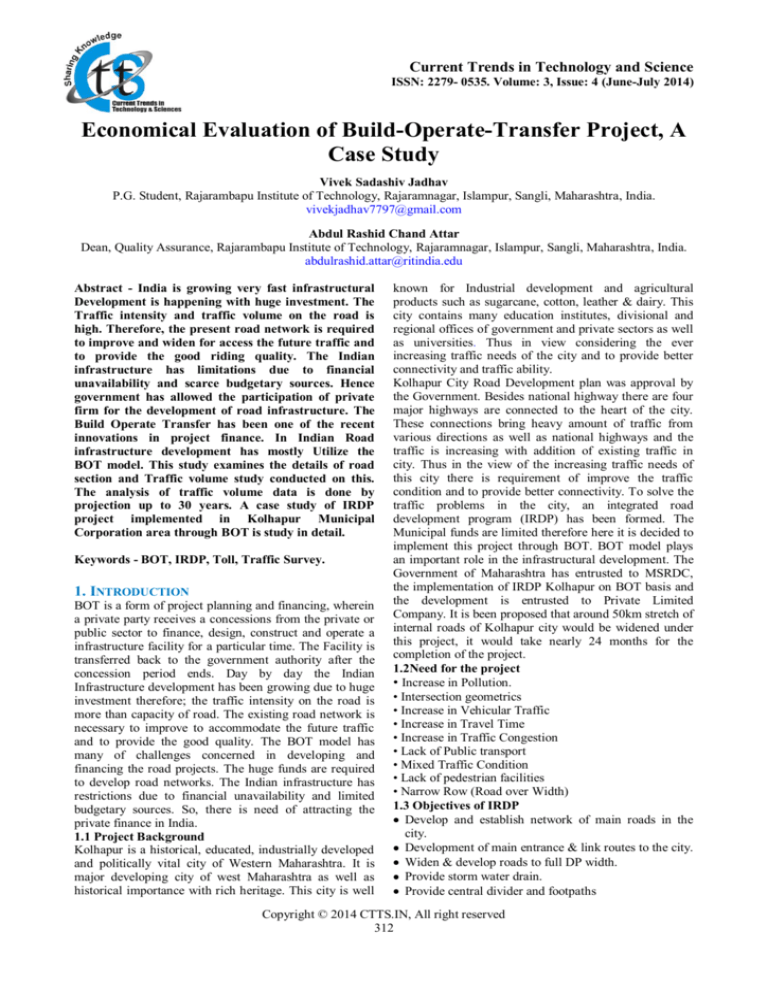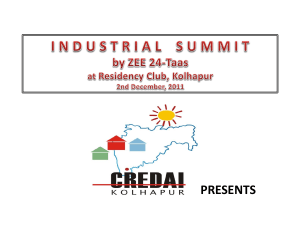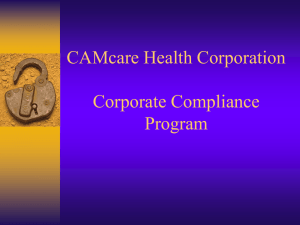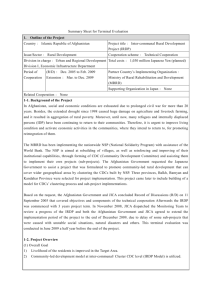
Current Trends in Technology and Science
ISSN: 2279- 0535. Volume: 3, Issue: 4 (June-July 2014)
Economical Evaluation of Build-Operate-Transfer Project, A
Case Study
Vivek Sadashiv Jadhav
P.G. Student, Rajarambapu Institute of Technology, Rajaramnagar, Islampur, Sangli, Maharashtra, India.
vivekjadhav7797@gmail.com
Abdul Rashid Chand Attar
Dean, Quality Assurance, Rajarambapu Institute of Technology, Rajaramnagar, Islampur, Sangli, Maharashtra, India.
abdulrashid.attar@ritindia.edu
Abstract - India is growing very fast infrastructural
Development is happening with huge investment. The
Traffic intensity and traffic volume on the road is
high. Therefore, the present road network is required
to improve and widen for access the future traffic and
to provide the good riding quality. The Indian
infrastructure has limitations due to financial
unavailability and scarce budgetary sources. Hence
government has allowed the participation of private
firm for the development of road infrastructure. The
Build Operate Transfer has been one of the recent
innovations in project finance. In Indian Road
infrastructure development has mostly Utilize the
BOT model. This study examines the details of road
section and Traffic volume study conducted on this.
The analysis of traffic volume data is done by
projection up to 30 years. A case study of IRDP
project implemented in Kolhapur Municipal
Corporation area through BOT is study in detail.
Keywords - BOT, IRDP, Toll, Traffic Survey.
1. INTRODUCTION
BOT is a form of project planning and financing, wherein
a private party receives a concessions from the private or
public sector to finance, design, construct and operate a
infrastructure facility for a particular time. The Facility is
transferred back to the government authority after the
concession period ends. Day by day the Indian
Infrastructure development has been growing due to huge
investment therefore; the traffic intensity on the road is
more than capacity of road. The existing road network is
necessary to improve to accommodate the future traffic
and to provide the good quality. The BOT model has
many of challenges concerned in developing and
financing the road projects. The huge funds are required
to develop road networks. The Indian infrastructure has
restrictions due to financial unavailability and limited
budgetary sources. So, there is need of attracting the
private finance in India.
1.1 Project Background
Kolhapur is a historical, educated, industrially developed
and politically vital city of Western Maharashtra. It is
major developing city of west Maharashtra as well as
historical importance with rich heritage. This city is well
known for Industrial development and agricultural
products such as sugarcane, cotton, leather & dairy. This
city contains many education institutes, divisional and
regional offices of government and private sectors as well
as universities. Thus in view considering the ever
increasing traffic needs of the city and to provide better
connectivity and traffic ability.
Kolhapur City Road Development plan was approval by
the Government. Besides national highway there are four
major highways are connected to the heart of the city.
These connections bring heavy amount of traffic from
various directions as well as national highways and the
traffic is increasing with addition of existing traffic in
city. Thus in the view of the increasing traffic needs of
this city there is requirement of improve the traffic
condition and to provide better connectivity. To solve the
traffic problems in the city, an integrated road
development program (IRDP) has been formed. The
Municipal funds are limited therefore here it is decided to
implement this project through BOT. BOT model plays
an important role in the infrastructural development. The
Government of Maharashtra has entrusted to MSRDC,
the implementation of IRDP Kolhapur on BOT basis and
the development is entrusted to Private Limited
Company. It is been proposed that around 50km stretch of
internal roads of Kolhapur city would be widened under
this project, it would take nearly 24 months for the
completion of the project.
1.2Need for the project
• Increase in Pollution.
• Intersection geometrics
• Increase in Vehicular Traffic
• Increase in Travel Time
• Increase in Traffic Congestion
• Lack of Public transport
• Mixed Traffic Condition
• Lack of pedestrian facilities
• Narrow Row (Road over Width)
1.3 Objectives of IRDP
Develop and establish network of main roads in the
city.
Development of main entrance & link routes to the city.
Widen & develop roads to full DP width.
Provide storm water drain.
Provide central divider and footpaths
Copyright © 2014 CTTS.IN, All right reserved
312
Current Trends in Technology and Science
ISSN: 2279- 0535. Volume: 3, Issue: 4 (June-July 2014)
Improvement of junctions.
Provide advanced street light illumination
Facilitate beautification to enhance aesthetics of the
roads.
2. DETAILS OF ROAD UNDER STUDY
2.1 Salient Features of the project
1. Client – Maharashtra State Road Development
Corporation
2. Concessionaire- IRB Pvt. Ltd.
3. Independent Consultant- PQR Ltd.
4. Letter of Acceptance- 27th March 2008
5. Signing of Agreement - 10th July 2008
6. Date of Commencement - 09Th January 2009
7. Project Cost - 220.00 Crores
8. Construction Period - 24 months
9. Concession Period - 30 years
2.2 Cost Estimate
Following table shows the cost estimate of proposed roads.
Sr.No.
Name of the Road
1
ER-1
Shiye naka to chimaso chawk
2
ER-2
Shiroli naka to shivaji bridgh
3
ER-3
Shahu naka to dsp office
4
ER-4
Kalamba naka to kalamba filter house
5
ER-5
Puikhadi to rankala chawpati
6
ER-6
Fulewadi naka to rankala chawpati
7
IR-1
Syber chawk to kalamaba filter house
8
IR-2
Kalamba filter house to mohite park
9
LR-1
Khanvilkar petrol pump to line bajar
10
LR-2
Rankala lake to Mahalakshimi temple
11
LR-3
Dasara chawk to ford corner
12
LR-4
Temblai gate to Uma theater
13
LR-5
Bagal chawk to Shivaji post office
14
1
Widening of Nala
15
2
Small Bridge
16
3
Cd Works
17
4
Railway Over Bridge
18
5
Roads
19
6
Toll Station
20
7
Bus Stops
21
8
High masts
23
A
Total Road and Infrastructural Cost
24
1
Land acquisition cost
25
2
office expenditures & Railway dept. deposits
26
3
Technical consultant fee
28
B
Total general cost
29
A+B
Total project cost
Table No.1
2.3 Crust Details
Composition
Thickness
AC
DBM
BM
WMM
Metal GSB Drainage Layer
Sub grade
40 mm
50 mm
75 mm
300 mm
200 mm
500 mm (8% CBR)
Total
1165 mm
Table No.2
Length (in m)
8.30
6.20
6.22
2.97
5.40
2.20
4.30
1.30
3.40
0.80
2.50
2.70
3.20
1 No.
8 No.
8 No.
1 No.
49 Km
9 No.
2 No.
45 No.
-
Costs in Lakhs
2681.96
2110.29
2263.93
861.97
1873.21
683.95
1608.83
377.29
986.77
232.18
725.57
760.02
949.39
100.00
320.00
67.50
1369.00
462.00
360.00
30.00
225.00
19257.00
850.00
1594.00
400.00
2844.00
220.00 Crores
2.4 Traffic Volume Survey
Traffic volume is the number of vehicles crossing a
section of road per unit time at any chosen time. Traffic
capacity or traffic volume is used as a amount measure of
vehicle flow; the commonly used units are vehicles per
day and vehicles per hour. Traffic volume survey was
carried out on 9 entry/ leaving points in Kolhapur. Table
gives the details of Traffic volume Survey in terms of
Average Daily Traffic (ADT). The following table no. 3
shows the traffic survey was carried out in Kolhapur city
entry/ leaving points.
Copyright © 2014 CTTS.IN, All right reserved
313
Current Trends in Technology and Science
ISSN: 2279- 0535. Volume: 3, Issue: 4 (June-July 2014)
Toll Plaza Locations
Shahu Naka
Uchagaon Naka
Vashi Naka
Shiye Naka
Phulewadi Naka
Kalamba Naka
Shiroli Naka
Total Vehicles
Total PCU
Car/Jeep/Van
/ 6S/ Auto
3888
3859
1730
1568
2077
887
11159
25168
25168
LCV
290
309
177
177
379
152
1191
2675
2675
ST
Bus
715
286
346
90
569
200
2355
4561
10034
Other
Bus
153
16
44
14
96
17
523
863
1899
Truck
MAV
Tractor
Total
541
437
462
432
931
283
2655
5741
12630
9
3
1
1
5
5
16
40
88
20
65
82
115
213
25
72
592
2368
5615
4975
2841
2398
4271
1567
17792
39459
54862
Table No.3
2.5 Traffic Growth
The following table shows the traffic growth rate of
Kolhapur IRDP Project as per the IRDP Tender
document.
Years
Traffic growth rate
Up to 10 years
7%
10 – 20 years
6%
20-30 years
5%
Table no.4
2.6 Passenger Car Unit
Sr.
Equivalency
Vehicle class
No.
factors
Car, pick up Van , auto
1.
1.0
rickshaw
2.
Bus, truck
3.0
3.
LCV
1.50
Motor cycle, scooter and
3.
0.5
pedal cycle
Truck Trailer, agricultural
4.
4.5
tractor-tailor unit
Table no.5
Various types of vehicles in a traffic flow have different
characteristics like width, length and height And
sometimes they produce cause inconvenience to other
vehicles, so for expressing highway capacity, a unit is
used called passenger car unit. Following table shows the
PCU factor suggested by IRC 108-1996.
2.7 Traffic Projection Up to 2038
Year
2007
2008
2009
2010
2011
2012
2013
2014
2015
2016
2017
2018
2019
2020
2021
2022
2023
2024
2025
2026
2027
2028
Car/ 6s/ Van
25168
26930
28815
30832
32990
35299
37770
40414
43243
46270
49509
52480
55629
58966
62504
66255
70230
74444
78910
83645
88664
93097
LCV/MB
2675
2862
3063
3277
3506
3752
4014
4295
4596
4918
5262
5578
5913
6267
6643
7042
7464
7912
8387
8890
9424
9895
Truck
5741
6143
6573
7033
7525
8052
8616
9219
9864
10555
11293
11971
12689
13451
14258
15113
16020
16981
18000
19080
20225
21236
Bus
5424
5804
6210
6645
7110
7607
8140
8710
9319
9972
10670
11310
11989
12708
13470
14279
15135
16043
17006
18026
19108
20063
Copyright © 2014 CTTS.IN, All right reserved
314
Tractor
40
43
46
49
52
56
60
64
69
74
79
83
88
94
99
105
112
118
125
133
141
148
MAV
592
633
678
725
776
830
888
951
1017
1088
1165
1234
1308
1387
1470
1558
1652
1751
1856
1967
2086
2190
Current Trends in Technology and Science
ISSN: 2279- 0535. Volume: 3, Issue: 4 (June-July 2014)
2029
2030
2031
2032
2033
2034
2035
2036
2037
97752
102639
107771
113160
118818
124759
130996
137546
144424
10390
10909
11455
12027
12629
13260
13923
14619
15350
22298
23413
24583
25813
27103
28458
29881
31375
32944
21067
22120
23226
24387
25607
26887
28231
29643
31125
155
163
171
180
189
198
208
219
230
2299
2414
2535
2662
2795
2935
3081
3235
3397
Table no.6
3. ECONOMICAL EVALUATION OF PROJECT
4. CONCLUSION
There are various methods available for economic
evaluation of highway projects, which is useful to
evaluate relative benefits which could be derived from
various alternative projects. The various methods of
economic evaluation of highway projects are discussed
briefly in the following.
Given Data:Analysis Period= 30 Years
Interest rate= 10 %
Construction Period= 2 Years
3.1 Benefit Cost Ratio
1. The traffic was 54862 PCU/day in the year 2007 is
exceeding the capacity of existing road. Hence there is a
need to widen the road. Hence the road is to be widened
up to four lanes.
2. The result of economic evaluation shows that Internal
Rate of Return for the road is 19 % and it is more than
the required interest rate of 10%, The Net Present Value
is 377.04 Crore and Hence the NPV is positive.
3. The Benefit Cost Ratio of Project is more than 1,
hence the project is accepted.
4. It can be concluded that the road is economically
viable for the proposed up gradation & improvements.
BCR = CF0/ (1 + i) 1 + CF1/ (1 + i) 2 + CF2/ (1 + i) 3 +
……….. + CFn/ (1 + i) n/Initial Investment
BCR = 2.14
BCR is >1, Hence Project is Accepted.
3.2 Net Present Value Method
In the net present value method, a project is equal to the
sum of present values of all the cash flows associated
with the project. The Net Present Value (NPV) at the base
year can be written as:
5. REFERENCES
NPV = CF0/ (1 + i)0 + CF1/ (1 + i)1 + CF2/ (1 + i)2
[3]
[1]
[2]
+ ……….. + CFn/(1 + i)n
NPV = 377.04 Crore
Hence NPV is Positive, The project is accepted.
3.3 Internal Rate of Return Method (IRR)
The IRR of a project is the discount rate which makes
NPV equal to zero.
[4]
[5]
IRR = CF0/ (1 + i) 0 + CF1/ (1 + i) 1 + CF2/ (1 + i) 2
+ ……….. + CFn/ (1 + i) n
IRR = 19 %
The Internal Rate of Return for 30 years has been
computed with the above formulas for the road section is
19 %.
3.4 Toll Rates
Type of Vehicle
Car/ 6S
LCV
Bus
Truck
MAV
Tractor
Toll In Rs.
15
20
35
35
40
35
[6]
[7]
[8]
Table no.7
[9]
S.K.Khanna,
C.E.G.Justo,
“Highway
Engineering”, Nem Chand and Bros., Roorkee,
U.K., India, Ninth Edition, pp. 159-211, 2011.
R. Panneerselvam, “Engineering Economics”, PHI
learning Private Limited, New Delhi, Thirteenth
Edition, pp. 26-67, 2012.
Kolhapur Municipal Corporation, “Kolhapur City
Integrated
Road
Development
Project”,
Presentation.
The Indian Roads Congress, “Guidelines for
Traffic Prediction on Rural Highways”, pp. 2-4,
1996.
The Indian Roads Congress, “Manual on
Economic Evaluation on Highway Projects In
India”, pp. 20-37, 1993.
Dr. (Mrs.) Vandana Tare, Er. Raj Mohammad
Khan, “Economic Evaluation of BOT Projects”,
Highway Engineering, Project Reports, Research
Papers, pp. 1-7.
Engineer Rinaj Pathan, Prof. Dr. S. S. Pimplikar,
“Case Study of Tolled Road Project”, IOSR
Journal of Mechanical and Civil Engineering
(IOSR-JMCE), Volume 7, Issue 6 PP 26-32, Jul. Aug. 2013.
Prof.(Dr.) R.K. Khitoliya, Dr. Pardeep Kumar
Gupta, Ashish Sharma, “Development of Technoeconomic Evaluation Methodology for Proposed
BOT based Highway Railway-Over-Bridge
Project”, New Building Material and construction
world, pp. 1-17.
Tender Document for IRDP Project.
Copyright © 2014 CTTS.IN, All right reserved
315





